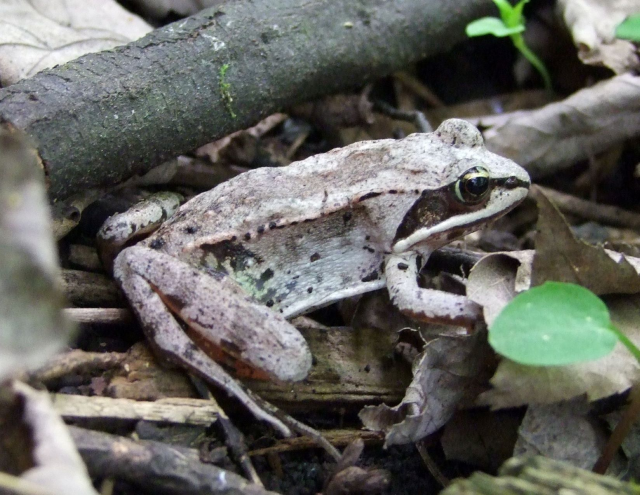WHERE DO ANIMALS GO DURING WINTER IN QUÉBEC?
Animals face two distinct challenges during winter: the cold and the shortage of food. Turns out that some have developed some pretty incredible strategies to make it through the winter, including turning themselves into icicles, fluttering straight across the continent, and spending the season in slow motion! Here are the winter survival strategies used by some animals native to Québec.
Spending the Winter in a Deep Freeze
Wood frogs turn completely into ice to survive the winter. Their heart stops beating, and their lungs shut down too. In the spring, their bodies defrost and come back to life. They pull off this trick thanks to their cells that fill with glucose, a viscous and organic antifreeze. This is what protects the cells from the freezing temperatures. Each cell remains intact while the cold freezes the water that surrounds it. In a study published in 2013 in the Journal of Experimental Biology, we learned that this glucose comes from glycogen stores found primarily in their liver. But a wood frog’s urine also plays a part in this trick. In 2018, American researchers showed that as winter approaches, wood frogs stop urinating so they can start storing another powerful and nontoxic antifreeze called urea. Urea is produced by the liver from a substance called ammonia (that becomes toxic at high levels). When frogs stop urinating, their bodies start storing this urea instead of eliminating it as they normally would through their kidneys.

Flying Thousands of Kilometres to Escape the Cold
Monarch butterflies escape the cold Québec winter by taking flight and travelling approximately 4,000 km south… to Mexico! But unlike Québecers who head down south to enjoy the Mexican sun on the beach, monarch butterflies choose to head for the mountains of Central Mexico. The temperatures here range between 1 and 6°C making it just warm enough to avoid freezing but cool enough to take a long winter nap until the spring. This nap is known as a diapause, a dormancy period that allows them to conserve energy and prolong their lifespan. But with the impacts of climate change over the last fifteen years or so, monarch colonies hibernating in Mexico are in decline. According to a study published in Animal Migration in 2018, monarchs from Québec may only be migrating as far south as Florida.
Cocooning Until the Spring
Some insects will escape to avoid Québec’s winter, but most protect themselves from the cold by hiding under tree bark, underground, or in our homes. Monarch butterflies use the diapause strategy during adulthood, but some insects use this strategy in their larval stage while wrapped in an egg, cocoon, or pupa. For example, when grasshoppers reproduce right before the winter just as they are dying, they protect their eggs with a protective pod allowing the eggs to survive the winter. Their hatchlings then emerge and start their new lives in the spring.
Slow Motion Living to Conserve Energy
Some mammals, like groundhogs and skunks, hibernate. While they spend the winter in this deep sleep, they use the fat their bodies have stored to stay alive. To make sure they don’t use up this precious source of energy too quickly, their body temperature and heart rate drop, and their breathing slows. For example, the Eastern chipmunk’s body temperature drops from 37°C to just 4°C and its heart rate drops from 350 beats per minute to… only four!

Contrary to popular belief, bears don’t hibernate, at least not in the true sense of the word. Their breathing slows and their heart rate drops just like truly hibernating species, but their body temperature drops only by a few degrees. It’s a state called torpor during which their brains stay active. This lighter state of sleep helps explain how mother bears will wake in January or February to give birth.
Guess what? Bears go all winter without going to the bathroom!
Their lower intestines form a fecal plug, that is, a plug made mostly of poo! This keeps airborne bacteria from entering their digestive system while they rest. So, what happens to all the metabolic waste their bodies generate over the winter? Their intestinal walls recycle much of it!
Others Stick Around for the Winter!
Some animals, like foxes and wolves, have dense fur that helps protect them from the cold. They also find enough prey in nature to survive the long Québec winter. So, they spend the season with us along with moose and the Canada Lynx, and others like white-tailed deer and owls and all those resourceful species that take advantage of our bird feeders (chickadees, cardinals, and blue jays) or that hide food and eat from their reserves all winter (like squirrels and beavers).
So, looks like there is plenty of wildlife to observe in Québec… even when it’s winter!

How can we help animals make it through the winter?
- Build them shelters (empty bird houses, piles of branches, insect hotels)
- Grow plants that bear fruit in the winter (like holly)
- Fill up those bird feeders
- Let them be and try not to bother them too much!
